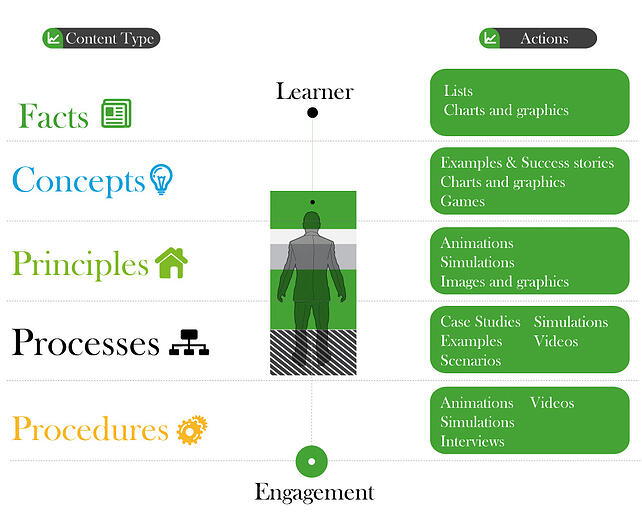When you're developing eLearning content for your company's training needs, you want your material to be engaging and interesting, but above all effective. You will need management buy-in for the training course's approval, so your eLearning content will have to be something that your manager feels comfortable describing to his manager.
But there is still no reason for boring eLearning content. Even very formal materials benefit from insights into training that grew from studying the millennial generation's learning patterns. You yourself probably learned from a book. But your company almost certainly has millennial employees, accustomed to internet surfing and non-linear reading. They have little patience for memorizing facts they can easily look up on their smartphones. And they are right.
Even employees who are used to training manuals really don't need to memorize anymore – if they really need to know how much video is uploaded to YouTube in a single minute they can look the number up. Meanwhile what matters is that it is a lot. We think it’s high time you experiment with other strategies to increase engagement levels. Read on for ten approaches we think you should be implementing to create great eLearning courses..

Case Studies
Case studies provide the proof that a certain strategy or decision will work if planned and applied correctly. Search and collect specific examples of how your company has been successful. Case studies could include facts and historical context, phases and steps, key players involved, and generated results. This is a great way to get learners involved and encourage immediate use of newly acquired skills.
Success Stories and Examples
Don’t hesitate to put dull and boring content in the form of a story. Supposing you're introducing a new product in the company, present different examples of cases that recently introduced products successfully. Including unsuccessful situations is also very important because students can analyze the most successful, creative and appealing approaches to find ways to improve them.
System Simulations
Many people learn by actually trying out a system (hands-on approach). Have a simulation available and have a group troubleshooting session for a typical support call. Your employees may even associate the new software with having fun while doing a great job solving problems. How cool is that? You now have a living breathing and interesting customer relations system.
Games
Games, interactive gadgets and toys apply better to some eLearning content than others. Animated characters interest everyone. For simple concepts it is sometimes best to take a humorous approach and gamification is one way to approach material that may seem almost insultingly elementary, yet which is not being retained. Check out SHIFT’s Game Engine, where you can choose over 20 different types of games.
Scenarios:
So the first type of eLearning content you need is scenarios. If you are training customer relations people, give them guidance on what a typical customer problem looks like and on preferred solutions for the more likely questions. Contrary of what you may think, scenarios don’t need to be complex (Check out SHIFT’s Scenario Builder).
Animations:
Animated graphic elements are great to use in your eLearning courses. They're attractive, and can get a message across that words or audio many times can’t. An animation can be s simple text animations, or even an animated character. They definitely take ordinary eLearning courses to new, exciting levels. Use animations for things like step-by-step procedures, course navigation, simulations, assessments or interactive material.
Images and graphics:
Images and graphics can be invaluable in getting a point across visually and as a full gestalt rather than as a set of facts to be regurgitated. There's a reason why so many organizations publish infographs – they will get a far more detailed examination, often, than would be afforded to a chunk of text.
Thought Leader Interviews:
Interviewing experts in the topic of your course or people recognized in your industry will provide great content that will entice your learners with their insights. It can be a video or text in a Q&A format. It’s a fact that videos of people have the best impact, not only for their humanizing effect, but they are more likely to inspire learners.
Video:
Video is always popular, but try to avoid uninterrupted sequences of talking heads. Even news shows where professional interviewers talk to fascinating people switch up camera angles and cut-ins and cut-outs, and intersperse visuals on the topic at hand. Short clips are the most effective and easily digested.
Quizzes:
Quizzes, judiciously applied, can be a fantastic learning tool. Students remember material they are tested on. Retrieving information somehow seems to move it to a more permanent storage slot. Quizzes have been shown to increase student retention. So test often. Don’t worry, there are tools like SHIFT that have more than fifteen customizable and pre-built templates that can instantly make your evaluations dynamic and engaging (check them out).
Creating engaging and effective eLearning courses can be resource intensive. The above ideas are just a small sampling of how to come up with great eLearning. Have any other ideas worked well for you? Please leave a comment below.








